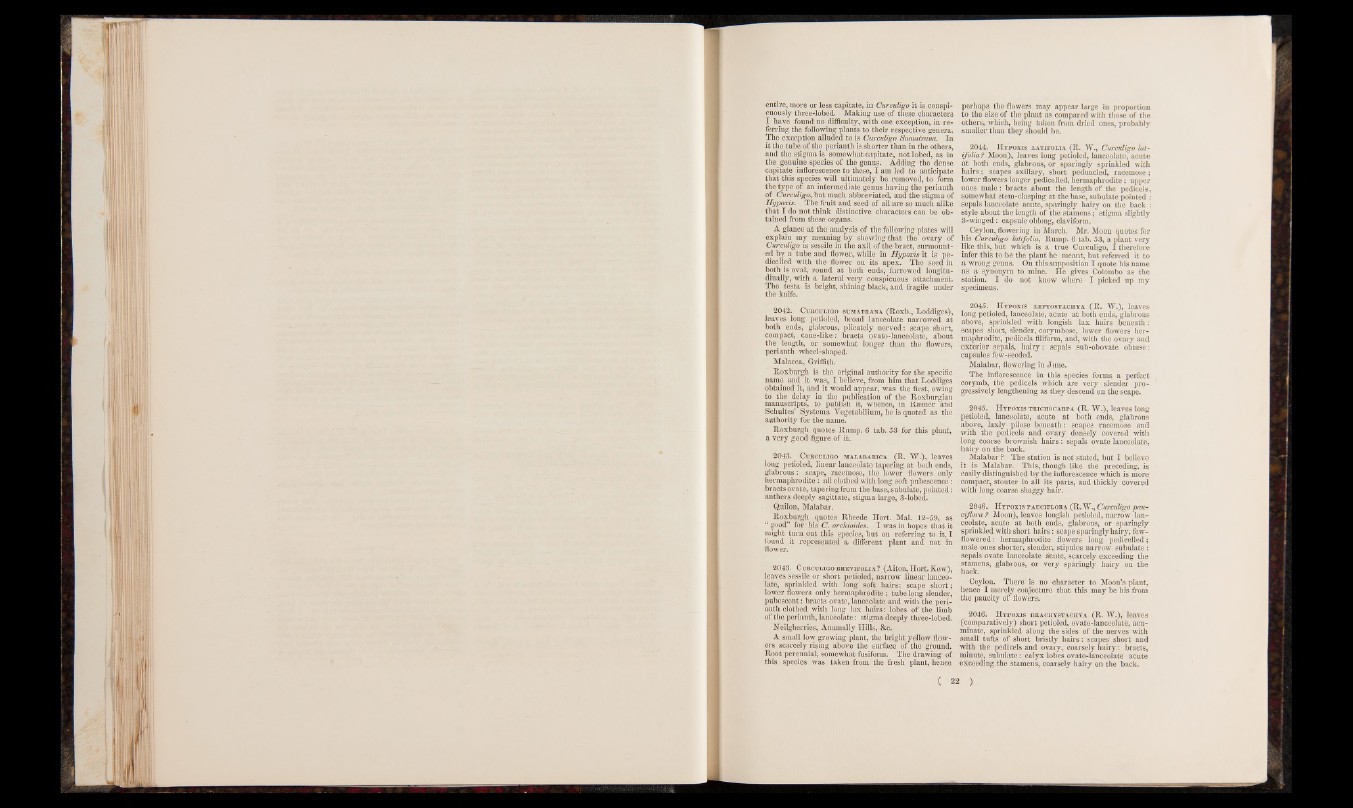
entire, more or less capitate, in Curculigo it is conspicuously
three-lobed. Making use of these characters
I have found no difficulty, with one exception, in referring
the following plants to their respective genera.
The exception alluded to is Curculigo Sumatrana. In
it the tube of the perianth is shorter than in the others,
and the stigma is somewhat capitate, not lobed, as in
the genuine species of the genus. Adding the dense
capitate inflorescence to these, I am led to anticipate
that this species will ultimately be removed, to form
the type of an intermediate genus having the perianth
of Curculigo, but much abbreviated, and the stigma of
Hypoxis. The fruit and seed of all are so much alike
that I do not think distinctive characters can be obtained
from these organs.
A glance at the analysis of the following plates will
explain my meaning by showing that the ovary of
Curculigo is sessile in the axil of the bract, surmounted
by a tube and flower, while in Hypoxis it is pedicelled
with the flower on its apex. The seed in
both is oval, round at both ends, furrowed longitudinally,
with a lateral very conspicuous attachment.
The testa is bright, shining black, and fragile under
the knife.
2042. Curculigo sumatrana (Roxb., Loddiges),
leaves long petioled, broad lanceolate narrowed at
both ends, glabrous, plicately nerved: scape short,
compact, cone-like: bracts ovato-lanceolate, about
the_ length, or somewhat longer than the flowers,
perianth wheel-shaped.
Malacca, Griffith.
Roxburgh is the original authority for the specific
name and it was, I believe, from him that Loddiges
obtained it, and it would appear, was the first, owing
to the delay in the publication of the Roxburgian
manuscripts, to publish it, whence, in Rsemer and
Schultes’ Systema Vegetabilium, he is quoted as the
authority for the name.
Roxburgh quotes Rump. 6 tab. 53 for this plant,
a very good figure of it.
2043. Curculigo malabarica (R. W.), leaves
long petioled, linear lanceolate tapering at both ends,
glabrous: scape, racemose, the lower flowers only
hermaphrodite: all clothed with long soft pubescence:
bracts ovate, tapering from the base, subulate, pointed:
anthers deeply sagittate, stigma large, 3-lobed.
Quilon, Malabar.
Roxburgh quotes Rheede Hort. Mai. 12-59, as
“ good” for'his C. orchioides. I was in hopes that it
might turn out this species, but on referring to it, I
found it represented a different plant and not in
flower.
2043. Curculigo brevifolia ? (Aiton, Hort. Kew),
leaves sessile or short petioled, narrow linear lanceolate,
sprinkled with long soft hairs: scape short;
lower flowers only hermaphrodite; tube long slender,
pubescent: bracts ovate, lanceolate and with the perianth
clothed with long lax hairs: lobes of the limb
of the perianth, lanceolate: stigma deeply three-lobed.
Neilgherries, Anamally Hills, &c.
A small low growing plant, the bright yellow flowers
scarcely rising above the surface of the ground.
Root perennial, somewhat fusiform. The drawing of
this species was taken from the fresh plant, hence
( 22
perhaps the flowers may appear large in proportion
to the size of the plant as compared with those of the
others, which, being taken from dried ones, probably
smaller than they should be.
2044. H ypoxis latifolia (R. W., Curculigo lat-
ifoliaf Moon), leaves long petioled, lanceolate, acute
at both ends, glabrous, or sparingly sprinkled with
h a irs; scapes axillary, short peduncled, racemose;
lower flowers longer pedicelled, hermaphrodite; upper
ones male: bracts about the length of the pedicels,
somewhat stem-clasping at the base, subulate pointed :
sepals lanceolate acute, sparingly hairy on the back :
style about the length of the stamens; stigma slightly
3-winged: capsule oblong, claviform.
Ceylon, flowering in March. Mr. Moon quotes for
his Curculigo latifolia, Rump. 6 tab. 53, a plant very
like this, but which is a true Curculigo, I therefore
infer this to be the plant he meant, but referred it to
a wrong genus. On this supposition I quote his name
as a synonym to mine. He gives Colombo as the
station. I do not know where I picked up my
specimens.
2045. H ypoxis leptostachya (R . W .), leaves
long petioled, lanceolate, acute at both ends, glabrous
above, sprinkled with longish lax hairs beneath:
scapes short, slender, corymbose, lower flowers hermaphrodite,'
pedicels filiform, and, with the ovary and
exterior sepals, h airy : sepals sub-obovate obtuse:
capsules few-seeded.
Malabar, flowering in June.
The inflorescence in this species forms a perfect
corymb, the pedicels which are very slender progressively
lengthening as they descend on the scape.
2045. H ypoxis trichocarpa (R. W.), leaves long
petioled, lanceolate, acute a t both ends, glabrous
above, laxly pilose beneath: scapes racemose and
with the pedicels and ovary densely covered with
long coarse brownish h a irs: sepals ovate lanceolate,
hairy on the back.
Malabar ? The station is not stated, but I believe
it is Malabar. This, though like the preceding, is
easily distinguished by the inflorescence which is more
compact, stouter in all its parts, and thickly covered
with long coarse shaggy hair.
2046. H ypoxis paucifloha (R. W ., Curculigo pau-
ciflora ? Moon), leaves longish petioled, narrow lanceolate,
acute at both ends, glabrous, or sparingly
sprinkled with short h airs: scape sparingly hairy, few-
flowered: hermaphrodite flowers long pedicelled;
male ones shorter, slender, stipules narrow subulate:
sepals ovate lanceolate acute, scarcely exceeding the
stamens, glabrous, or very sparingly hairy on the
back.
Ceylon. There is no character to Moon’s plant,
hence I merely conjecture that this may be his from
the paucity of flowers. '
2046. H ypoxis brachystachya (R. W.), leaves
(comparatively) short petioled, ovato-lanceolate, acuminate,
sprinkled along the sides of the nerves with
small tufts of short bristly h a irs: scapes short and
with the pedicels and ovary, coarsely hairy: bracts,
minute, subulate: calyx lobes ovato-lanceolate acute
exceeding the stamens, coarsely hairy on the back.
)